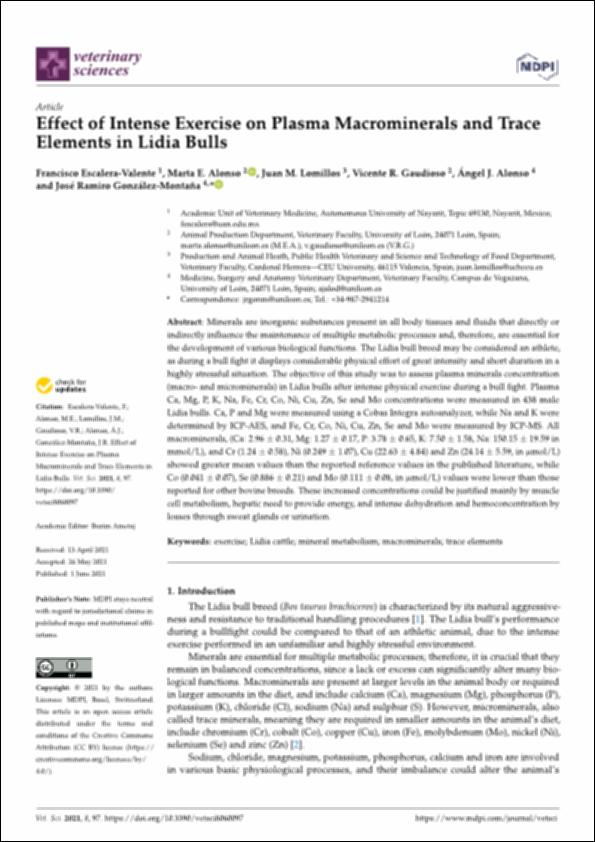Por favor, use este identificador para citar o enlazar este ítem:
http://hdl.handle.net/10637/14001Effect of intense exercise on plasma macrominerals and trace elements in lidia bulls
| Título : | Effect of intense exercise on plasma macrominerals and trace elements in lidia bulls |
| Autor : | Escalera Valente, Francisco Alonso de la Varga, Marta Elena Lomillos Pérez, Juan Manuel Gaudioso Lacasa, Vicente R. Alonso Díez, Ángel Javier González Montaña, José Ramiro |
| Materias: | Metabolismo energético.; Energy metabolism.; Mineral metabolism.; Fighting bull - Metabolism.; Metabolismo mineral.; Toros de lidia - Metabolismo. |
| Editorial : | MDPI |
| Citación : | Escalera-Valente, F., Alonso, M., Lomillos, J., Gaudioso, V., Alonso, Á., & González-Montaña, J. (2021). Effect of intense exercise on plasma macrominerals and trace elements in lidia bulls. Veterinary Sciences, vol. 8, i. 6 (01 jun.), art. 97. DOI: http://dx.doi.org/10.3390/vetsci8060097 |
| Resumen : | Minerals are inorganic substances present in all body tissues and fluids that directly or indirectly influence the maintenance of multiple metabolic processes and, therefore, are essential for the development of various biological functions. The Lidia bull breed may be considered an athlete, as during a bull fight it displays considerable physical effort of great intensity and short duration in a highly stressful situation. The objective of this study was to assess plasma minerals concentration (macro- and microminerals) in Lidia bulls after intense physical exercise during a bull fight. Plasma Ca, Mg, P, K, Na, Fe, Cr, Co, Ni, Cu, Zn, Se and Mo concentrations were measured in 438 male Lidia bulls. Ca, P and Mg were measured using a Cobas Integra autoanalyzer, while Na and K were determined by ICP-AES, and Fe, Cr, Co, Ni, Cu, Zn, Se and Mo were measured by ICP-MS. All macrominerals, (Ca: 2.96 0.31, Mg: 1.27 0.17, P: 3.78 0.65, K: 7.50 1.58, Na: 150.15 19.59 in mmol/L), and Cr (1.24 0.58), Ni (0.249 1.07), Cu (22.63 4.84) and Zn (24.14 5.59, in mol/L) showed greater mean values than the reported reference values in the published literature, while Co (0.041 0.07), Se (0.886 0.21) and Mo (0.111 0.08, in mol/L) values were lower than those reported for other bovine breeds. These increased concentrations could be justified mainly by muscle cell metabolism, hepatic need to provide energy, and intense dehydration and hemoconcentration by losses through sweat glands or urination. |
| Descripción : | Este artículo se encuentra disponible en la siguiente URL: https://www.mdpi.com/2306-7381/8/6/97 |
| URI : | http://hdl.handle.net/10637/14001 |
| Derechos: | http://creativecommons.org/licenses/by/4.0/deed.es |
| ISSN : | 2306-7381 (Electrónico) |
| Fecha de publicación : | 1-jun-2021 |
| Centro : | Universidad Cardenal Herrera-CEU |
| Aparece en las colecciones: | Dpto. Producción y Sanidad Animal, Salud Pública Veterinaria y Ciencia y Tecnología de los Alimentos |
Los ítems de DSpace están protegidos por copyright, con todos los derechos reservados, a menos que se indique lo contrario.


